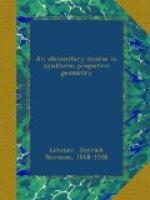174. In the “Essay” Pascal gives full credit to Desargues, saying of one of the other propositions, “We prove this property also, the original discoverer of which is M. Desargues, of Lyons, one of the greatest minds of this age ... and I wish to acknowledge that I owe to him the little which I have discovered.” This acknowledgment led Descartes to believe that Pascal’s theorem should also be credited to Desargues. But in the scientific club which the young Pascal attended in company with his father, who was also a scientist of some reputation, the theorem went by the name of ‘la Pascalia,’ and Descartes’s remarks do not seem to have been taken seriously, which indeed is not to be wondered at, seeing that he was in the habit of giving scant credit to the work of other scientific investigators than himself.
175. De la Hire and his work. De la Hire added little to the development of the subject, but he did put into print much of what Desargues had already worked out, not fully realizing, perhaps, how much was his own and how much he owed to his teacher. Writing in 1679, he says,(13) “I have just read for the first time M. Desargues’s little treatise, and have made a copy of it in order to have a more perfect knowledge of it.” It was this copy that saved the work of his master from oblivion. De la Hire should be credited, among other things, with the invention of a method by which figures in the plane may be transformed into others of the same order. His method is extremely interesting, and will serve as an exercise for the student in synthetic projective geometry. It is as follows: Draw two parallel lines, _a__ and __b__, and select a point __P__ in their plane. Through any point __M__ of the plane draw a line meeting __a__ in __A__ and __b__ in __B__. Draw a line through __B__ parallel to __AP__, and let it meet __MP__ in the point __M’__. It may be shown that the point __M’__ thus obtained does not depend at all on the particular ray __MAB__ used in determining it, so that we have set up a one-to-one correspondence between the points __M__ and __M’__ in the plane._ The student may show that as M describes a point-row, M’ describes a point-row projective to it. As M describes a conic, M’ describes another conic. This sort of correspondence is called a collineation. It will be found that the points on the line b transform into themselves, as does also the single point P. Points on the line a transform into points on the line at infinity. The student should remove the metrical features of the construction and take, instead of two parallel lines a and b, any two lines which may meet in a finite part of the plane. The collineation is a special one in that the general one has an invariant triangle instead of an invariant point and line.




